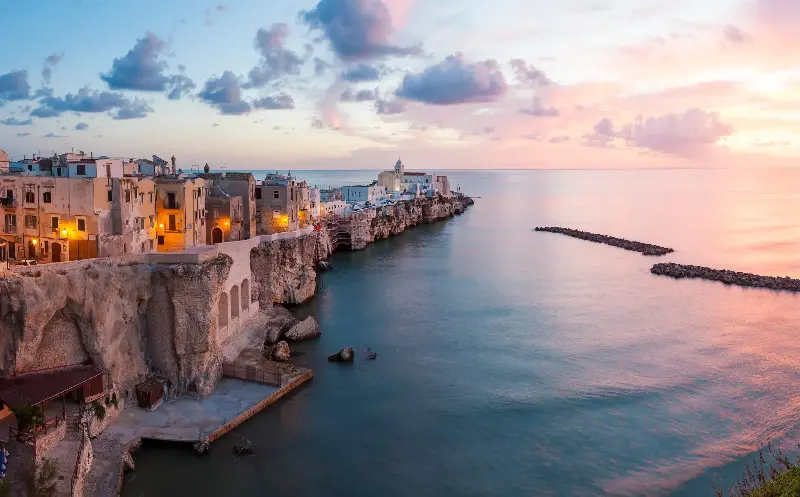
Puglia’s 800km-long coastline (Italy’s longest) is brimming with endless olive groves, sun-bleached villages and elderly men shooting the breeze in village squares. Its heritage is a mix of Baroque churches, Norman castles, fishing harbours and cucina povera (humble dishes). Much of it feels like rewinding the clock – to a time when people tanned without concern and cash was the default currency.
Most overseas visitors gravitate to the Valle d’Itria, an area of olives, orchards, trulli (pointed roof houses) and gleaming white towns, while Italians from the north come in their thousands to pack Puglia’s long beaches in summer. The Gargano juts into the Adriatic, with forested hills and fine beaches. South lies Salento, the heel proper, where cliffs drop into the Adriatic on one side, and powdery Ionian sands beckon on the other.
For more Puglia inspiration, see our guides to the region’s best hotels, restaurants, bars, things to do and beaches. Plan your 10-day trip with our ultimate itinerary.
In this guide:
- How to spend the perfect day in Puglia
- How to spend the perfect week in Puglia
- When to go
- Where to stay
- How to get there and how to get around
- Know before you go
How to spend the perfect day
The perfect day: morning
Arrive in the early morning. From the airport, stretch your legs on the streets of Bari’s Old Town – seeing the nonne making Puglian speciality orecchiette pasta, with tables and drying racks set out on the narrow streets – before travelling on to your base, in Valle d’Itria, an area of olive groves and hilltop towns. Staying at one of Puglia’s masserie (grand fortified farmhouses) turned rustic-chic hotels, such as Masseria le Torri. Its chalky façade gleams under the southern sun, with gardens shaded by fig, olive, mulberry and cherry trees.
A short, scenic drive brings you to Polignano a Mare, a white-washed town on seacliffs above the turquoise Adriatic. Pause for a theatrical caffe speciale (espresso, Amaretto di Saronno, lemon zests, whipped cream and sugar) at Super Mago del Gelo Mario Campinella, whose interior is like stepping into a postcard, with walls lined by ocean-blue prints of local landmarks. Then explore Polignano’s historic walled centre, and wander to Lama Monachile, a beautiful scrap of beach sandwiched by limestone cliffs.
Afternoon
From Polignano, it’s a 30-minute train or car ride east along the coast to Monopoli, a honey-golden stone port bobbing with royal blue-hulled fishing boats. It’s not as if you need to fit in seeing lots of sights here, just enjoy the portside atmosphere, where fishermen untangle their nets. Settle in for a leisurely lunch al fresco at Carlo Quinto, tucked into the old bastion with tables spilling onto sun-warmed flagstones, with only the old walls between you and the Adriatic. The menu focuses on the day’s catch: grilled prawns, octopus salad, clams, mussels and fresh fish.
If you feel like relaxing on the beach there’s a lovely little town option, backed by the golden bastions at Cala Porta Vecchia – if you linger long enough you can join in the local passeggiata (early evening stroll) along the seafront promenade.
Evening
As dusk falls, head inland (30 minutes drive) to Cisternino, a gleaming hilltop town scented by citrus trees and olive groves. Its old quarter is a tangle of narrow lanes and whitewashed homes, balconies spilling with bougainvillaea and blazing geraniums. Here, take a wander, the narrow streets opening onto flashes of sea on the horizon where the land flattens toward the Adriatic, a radiant blue line along the horizon.
The town’s famed fornelli pronti “ready ovens” are butchers with dining areas. Pick your meats from the counter – bombette (stuffed pork rolls) are the local speciality – and settle in for a barbecued feast, accompanied by a carafe of local wine and a sky turning rose above the olive trees.
How to spend a week-long holiday
Puglia is a long, narrow region, and many visitors choose to explore either the north, central, or southern area. This week-long itinerary offers a taste of highlights across the region, though many more could be included.
After your perfect day exploring Polignano, Monopoli and Cisternino, discover more of the Valle d’Itria, starting with Alberobello, the most famous and photographed place in Puglia. A sea of white-washed, pointed-roofed houses, it resembles something from a storybook. Stop here for an hour or so to explore its many souvenir shops, before driving across the countryside to Locorotondo, another of Italy’s most beautiful villages, with a historic centre. It’s famous for its sparkling white wine, Bianco Locorotondo DOC; try it at Pavì wine restaurant, with top-of-the-world views over vineyards and fields and the sea on the horizon.
From here, it’s a half-hour drive to the snow-white queen of Puglia’s hilltop towns, Ostuni. The historic centre is moderately steep and largely pedestrianised, with narrow lime-white streets resembling a transplanted Andalucian village. Eat at Ostuni Bistrot on the main square, which offers pinse – a lighter version of pizza – and great antipasti. Follow with more meanderings around the mazelike centre, stopping for a silky artisanal gelato from Cremeria Alla Scala.
It’s an hour’s drive from Ostuni to Lecce. This golden-stone university town’s historic centre has grand piazzas, baroque churches and narrow quiet lanes. It could make a good base for a day or two’s exploration, and you can eat well at restaurants such as Alle Due Corti.
A half-hour away lies Porto Cesareo, where the Ionian Sea laps at Caribbean-white sands. From here, drive along the coast to Gallipoli, a fortified town on an island that’s an ideal place for a sundowner with views over the sea from the bastions. Eat at old-school seafood restaurant, La Puritate. Galatina is only half an hour away by car, with a handsome historic centre and the frescoed church of Santa Caterina. It’s a good place to eat pasticciotti (custard-filled cakes) at Pasticceria Andrea Ascalone, where they were invented. For your final stop, head to Otranto on the Adriatic Coast, a historic fortified town, with beautiful beaches, such as the wild Baia dei Turchi.
When to go
Many hotels and restaurants in Puglia only begin to open at Easter. Spring is a lovely time to visit, when the countryside is carpeted in flowers. From June onwards, sunshine is largely guaranteed. It’s very hot in July and August, and the coast is rammed with Italian holidaymakers, but there’s a fun atmosphere with festivals and sagre every night. September is quiet, prices are lower, and the weather is still great, which may well continue into October.
Where to stay
Luxury Living
There’s nowhere quite like Borgo Egnazia, a purpose-built tribute to a traditional Puglian village. Despite being flush with facilities, the hotel achieves an intimacy through phenomenally personable staff and its six resolutely Italian restaurants. The four salt-water pools, various candlelit corners and bonus beach club secure its position as one of the country’s finest hotels.
Read our full review here.
Boutique Beauty
Castello di Ugento is a historic monument whose roots go back to the Normans. It has had a new lease of life as a luxury hotel and state-of-the-art cookery school. Ancient architecture and contemporary design combine to provide a majestic home-from-home which provides the best in Puglian hospitality and cuisine.
Read our full review here.
Budget Bolthole
Sotto Le Cummerse is an albergo diffuso (or scattered hotel), strewn across the delightful hill-town of Locorotondo, offering a taste of traditional Puglian style in 10 B&B apartments with the option of self-catering. The borgo overlooks the fertile Itria Valley – a paradise for hiking, biking and trulli spotting.
Read our full review here.
Find more Puglia hotels in our guide.
How to get there and how to get around
Puglia is served by Bari and Brindisi airports, with seasonal UK flights from Ryanair, easyJet and British Airways. Bari’s station connects to Lecce, Brindisi and Taranto via Trenitalia. Four regional rail lines link towns like Polignano, Monopoli, Ostuni and Grottaglie, though some stations require bus or taxi transfers. Car hire is most convenient from the airports, and is ideal for exploring rural areas and more remote parts of the coast. Taxis can be costly; historic centres are easily explored on foot.
Know before you go
Essential information
Tourist information: Pugliapromozione – Puglia Region Tourism Board; Fiera del Levante, Pad. 172, Lung. Starita 4, 70132 Bari; 0039 0805821425
Currency: Euro €
Telegraph code from abroad: +39
Time difference: Central European Time (CET) 1hr ahead of UK time
Travel time from London: 2h50m to Bari by plane
Local laws and etiquette
- Dress modestly when visiting churches.
- Recycling rules are strict; separate waste carefully.
- Tipping is appreciated but not obligatory.
- Businesses are usually closed for two to three hours over lunch and on Sundays.
Accessibility
Puglia’s historic towns have narrow, uneven streets that may be difficult to negotiate. Larger cities like Bari and Lecce offer better facilities, including some hotels with adapted rooms.
About our expert
Abigail Blasi, Telegraph Travel’s Puglia expert, fell for the region – and her Puglian husband – over 20 years ago. She loves its spring flowers, summer sagre, burrata, and discovering hidden corners of Italy’s heel.
